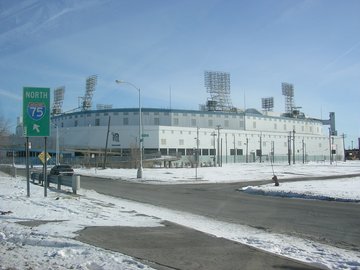Tiger Stadium
|
|

Tiger Stadium | |
| Location | Detroit, Michigan |
| Opened | April 20, 1912 |
| Capacity |
23,000 (1912) |
| Owned by | The City of Detroit |
| Architect: |
Osborn Engineering |
|
Dimensions
|
|
Tiger Stadium, often called "The Corner" (as it is at the corner of Michigan Avenue and Trumbull Street), is a stadium located in the Corktown neighborhood of downtown Detroit, Michigan. It hosted the Detroit Tigers Major League Baseball team for nearly a century before it moved into the new Comerica Park in 2000. It is listed on the National Register of Historic Places.
History
In 1895, Detroit Tigers owner George Vanderbeck had a new ballpark built at the corner of Michigan and Trumbull avenues. That stadium was called Bennett Park and featured a wooden grandstand with a wooden peaked roof in the outfield and bleachers surrounding the infield. At the time, some places in the outfield were only marked off with rope.
In 1911, new Tigers owner Frank Navin ordered a new steel-and-concrete baseball park on the same site that would seat 23,000 to accommodate the growing numbers of fans and on April 20, 1912, Navin Field was opened, the same day as the Boston Red Sox's Fenway Park.
Over the years, expansion continued to accommodate more people. In 1935, following the death of Frank Navin, new owner Walter Briggs oversaw the expansion of Navin Field to a capacity of 36,000 by extending the upper deck to the foul poles and across right field. By 1938, the city had agreed to move Cherry Street, allowing left field to be double-decked, and the now-renamed Briggs Stadium had a capacity of 53,000.
Also in 1938, the Detroit Lions of the National Football League began a relationship that allowed them to host their home games at Briggs Stadium. They would play there through 1974, when their new home, the Pontiac Silverdome, opened in Pontiac, Michigan.
In 1961, new owner John Fetzer took control of the stadium and gave it its permanent name: Tiger Stadium. The stadium was home to the Tigers through championship seasons in 1968 and 1984.
The stadium became known in the 1970s and 1980s for its old facilities and obstructed views, but was beloved by local baseball fans for its historic feel. Box and most reserved seats were close to the action. During the 1990s as plans began to construct a new park, many campaigned to save the stadium.
On September 27, 1999, the final Detroit Tigers game was held at Tiger Stadium. Following the game, an emotional ceremony with past and present Tigers greats was held to mark the occasion. The Detroit Tigers moved to the newly constructed Comerica Park for their 2000 season leaving Tiger Stadium largely unused.
On July 24, 2001, a Great Lakes Summer Collegiate Game between the Motor City Marauders and the Lake Erie Monarchs was played at Tiger Stadium. It was in an effort by a local sports management company that is seeking to bring a minor-league franchise to Detroit in the Frontier League.
In August 2001, the HBO TV movie 61* was filmed in Tiger Stadium. To make the field appear to be Yankee Stadium, the seats were painted green and a third deck and skyline of the Bronx were added through the use of CG. In the credit roll at the end of the film, Yankee Stadium is listed as a character played by Tiger Stadium. Ironically, it was at Tiger Stadium that Roger Maris hit his first home run of his record breaking 1961 season.
It was also depicted in the movies Tigertown, a baseball movie, and (as Briggs Stadium) in Raging Bull as the site of two of Jake LaMotta's championship boxing matches.
Since the departure of the Detroit Tigers the city of Detroit has spent nearly $4 million maintaining Tiger Stadium with no interest from any developers in transforming or using the aged park.
Trivia
- Had an in-play, 125 ft (38 m) tall flagpole to the left of dead center field at the 440 ft (134 m) mark.
- The right-field upper deck overhung the field by 10 feet (3 m), prompting the installation of lights above the warning track.
- Was the second-to-last stadium to install lights for night play, before Wrigley Field.
- Had the only upper-deck bleachers in the major leagues.
- Was host to 11,111 home runs, the last a mammoth, right field, roof top grand slam by Detroit's Robert Fick in the last game played there.
- The depth in straightaway center field was actually 425 ft (130 m), not the 440 ft (134 m) as shown on the centerfield wall.
- Tiger Stadium was home to the Detroit Lions from 1938 to 1974 when they dropped their final Tiger Stadium game to the Denver Broncos on Thanksgiving Day. The football field ran mostly in the outfield from the right field line to left center field parallel with the third base line. The benches for both the Lions and their opponents were on the outfield side of the field.
- May 2, 1939, will be forever remembered in the annals of baseball as the day New York Yankees first baseman Lou Gehrig voluntarily benched himself at Briggs Stadium, ending a streak of 2,130 consecutive games.
External links
- Past Tigers Venues (http://detroit.tigers.mlb.com/NASApp/mlb/det/ballpark/det_ballpark_venues.jsp)
- USGS aerial photo (http://terraserver.microsoft.com/image.aspx?T=4&S=9&Z=17&X=3295&Y=46887&W=1&qs=%7cdetroit%7cmi%7c)

